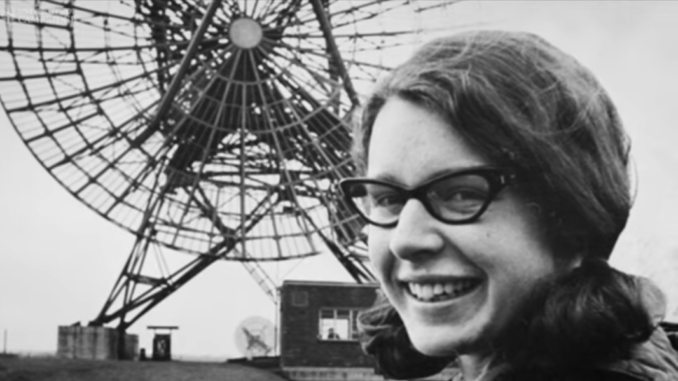
Susan Jocelyn Bell, born 15 July 1943 into a Quaker family in Lurgan, Northern Ireland, is one of those lucky people who grew up and entered the profession that she’d become passionate about as a child. Her father, an architect, had worked on the design of nearby Armagh Planetarium and happened to have a genuine interest in astronomy, as evidenced by his personal collection of books on the subject (which he encouraged her to read). On several occassions he took his children to visit both the planetarium and adjacent Armagh Observatory, where the staff encouraged her budding interest in the stars. At age 14, she became engrossed in a library book her dad had brought home, called “Frontiers of Astronomy” by Fred Hoyle, a famous astronomer. Although it was a challenging text for a young teenager, she read the entire volume. From that point on, Hoyle became an important influence.
A third major influence was her physics teacher at a Quaker boarding school for girls in York, England, that she attended as a teenager. Mr Tillott excelled at making science easy to understand, and Jocelyn was accepted into University of Glasgow. There, she earned a Bachelor of Science degree in Natural Philosophy (physics), with honours, graduating in 1965. By this time, she knew she wanted to specialize in radio astronomy – the study of the stars using radio wave receivers to detect the electromagnetic radiation they emit.
To her surprise, the University of Cambridge accepted her into postgraduate school. Her doctoral supervisor was Antony Hewish, who was researching quasars and building a giant but simple radio telescope dubbed the Interplanetary Scintillation Array (ISA). A team of graduate students, including Jocelyn, labored two years to build the ISA which covered 4 acres (later expanded to 9 acres) and included 4,096 dipole antennas arranged in a square array. After two years of hard physical work, Jocelyn was the sole grad student assigned to operate the telescope, which included analyzing the data it recorded on 100 foot long rolls of graph paper. As the Earth rotated, the ISA picked up any and all radio signals directly overhead in the 81.5 MHz (megahertz) radio frequency range. Primarily, it received signals from the cosmos, but it also picked up unwanted noise and interference from terrestrial sources. Jocelyn learned to tell the difference between good data and spurious noise.
On 28 November 1967, she noted a “bit of scruff” on a section of the graph paper. Going back through yards and yards of the graph rolls, she spotted another example of the signal which had been recorded the previous August. Further analysis lead her to believe this signal originated from a point in space because it was picked up the same sidereal time each day. (Sidereal time is measured relative to the apparent rotation of the fixed stars around the Earth, as opposed to Solar time which uses the Sun rather than the stars as a reference point). Knowing what time of day to expect the signal and by speeding up the graph paper during recording, she was able to expand the squiggly lines of “bit of scruff” into something legible. It was then plain to see the signal repeated, or pulsed, every 1.337 seconds.
Hewish was not convinced and initially believed it was nothing but terrestrial noise. However, when it became clear that the signal was repeating on sidereal time, he became very interested. Jocelyn started looking for other examples in the data of this pulse. She found a second one, in a different part of the sky. Then a third, and a fourth. Now they really had something they could write a paper on. The new objects Jocelyn had discovered were dubbed pulsating radio sources, or pulsars.
Jocelyn earned her Ph.D, married, and became known as Jocelyn Bell Burnell. She left Cambridge and went on to a rewarding and satisfying career in astrophysics. However, she never got full credit for her discovery, while Hewish and his boss earned the Nobel Prize in 1974 for the discovery of pulsars. There was quite a bit of controversy involved, with Hoyle and other major figures crying foul on Jocelyn’s behalf. But graduate students never get recognition by Nobel committees, and she seemed to understand that.
Since then, she’s received many awards, accolades, and honors, as well as being named Dame Susan Jocelyn Bell Burnell DBE FRS FRSE FRAS FInstP.
“NASA | What is a Pulsar?” (1:36):
“Journeys of Discovery: Jocelyn Bell Burnell and Pulsars” (6:16):
“Dame Jocelyn Bell Burnell describes the discovery of pulsars” (2:47):
“Jocelyn Bell Burnell describes how she discovered pulsars – Beautiful Minds_Ep1 Preview_BBC Four” (2:17):
Question Of The Night: Who was your favorite or best teacher, and what made them great?
